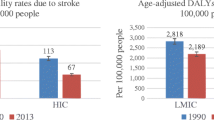Opinion statement
The 25% of Americans living in rural areas receive suboptimal stroke care. To eliminate the current disparity in rural acute stroke care, we need a comprehensive plan of education and increased resources targeting all levels of the paradigm. This plan includes improving recognition of stroke in rural areas, rural prehospital emergency services, emergency room care in small hospitals, remote support from tertiary stroke centers, and expeditious interhospital transfer with adequate communication and transfer of data between all the stakeholders. Because stroke trials are generally conducted by expert vascular neurologists working in large urban academic centers, physicians in small rural hospitals cannot be expected to immediately embrace future stroke therapies that were not tested in their system of care. The methodology of stroke trials needs to be adapted to allow the inclusion of a proportional number of patients treated in small, rural hospitals in order to improve fairness and adequately generalize future stroke therapies to large, underserved areas.
Similar content being viewed by others
References and Recommended Reading
US Census Bureau: GCT-P1: Urban/Rural and Metropolitan/Nonmetropolitan Population: 2000. http://factfinder.census.gov/servlet/GCTTable?_bm=y&-geo_id=&-ds_name=DEC_2000_SF1_U&-_lang=en&-redoLog=true&-mt_name=DEC_2000_SF1_U_GCTP1_US1&-format=US-1&-CONTEXT=gct. Accessed August 19, 2008.
Pearson TA, Lewis C: Rural epidemiology: insights from a rural population laboratory. Am J Epidemiol 1998, 148:949–957.
Eberhardt MS, Pamuk ER: The importance of place of residence: examining health in rural and nonrural areas. Am J Public Health 2004, 94:1682–1686.
Knott A: Emergency medical services in rural areas: the supporting role of state EMS agencies. J Rural Health 2003, 19:492–496.
Qureshi AI, Suri MF, Nasar A, et al.: Changes in cost and outcome among US patients with stroke hospitalized in 1990 to 1991 and those hospitalized in 2000 to 2001. Stroke 2007, 38:2180–2184.
The National Institute of Neurological Disorders and Stroke rt-PA Stroke Study Group: Tissue plasminogen activator for acute ischemic stroke. N Engl J Med 1995, 333:1581–1587.
Kleindorfer D, Kissela B, Schneider A, et al., for The Neuroscience Institute: Eligibility for recombinant tissue plasminogen activator in acute ischemic stroke: a population-based study. Stroke 2004, 35:e27–e29.
Leira EC, Pary JK, Davis PH, et al.: Slow progressive acceptance of intravenous thrombolysis for patients with stroke by rural primary care physicians. Arch Neurol 2007, 64:518–521.
Alkadry MG, Wilson C, Nicholson D: Stroke awareness among rural residents: the case of West Virginia. Soc Work Health Care 2005, 42:73–92.
Rowe AK, Frankel MR, Sanders KA: Stroke awareness among Georgia adults: epidemiology and considerations regarding measurement. South Med J 2001, 94:613–618.
Blades LL, Oser CS, Dietrich DW, et al.: Rural community knowledge of stroke warning signs and risk factors. Prev Chronic Dis 2005, 2:A14.
Gebhardt JG, Norris TE: Acute stroke care at rural hospitals in Idaho: challenges in expediting stroke care. J Rural Health 2006, 22:88–91.
Suyama J, Crocco T: Prehospital care of the stroke patient. Emerg Med Clin North Am 2002, 20:537–552.
Okon NJ, Rodriguez DV, Dietrich DW, et al.: Availability of diagnostic and treatment services for acute stroke in frontier counties in Montana and Northern Wyoming. J Rural Health 2006, 22:237–241.
Becknell J, Ostrow LS: EMS in rural America. Emerg Med Serv 2002, 31:41–48.
Burgin WS, Staub L, Chan W, et al.: Acute stroke care in non-urban emergency departments. Neurology 2001, 57:2006–2012.
Kothari R, Sauerbeck L, Jauch E, et al.: Patients’ awareness of stroke signs, symptoms, and risk factors. Stroke 1997, 28:1871–1875.
Wein TH, Staub L, Felberg R, et al.: Activation of emergency medical services for acute stroke in a nonurban population: the T.L.L. Temple Foundation Stroke Project. Stroke 2000, 31:1925–1928.
Kothari RU, Pancioli A, Liu T, et al.: Cincinnati Prehospital Stroke Scale: reproducibility and validity. Ann Emerg Med 1999, 33:373–378.
Kidwell CS, Starkman S, Eckstein M, et al.: Identifying stroke in the field: prospective validation of the Los Angeles Prehospital Stroke Screen (LAPSS). Stroke 2000, 31:71–76.
Hobbs GD, Moshinskie JF, Roden SK, Jarvis JL: A comparison of classroom and distance learning techniques for rural EMT-I instruction. Prehosp Emerg Care 1998, 2:189–191.
Fisher M: Developing and implementing future stroke therapies: the potential of telemedicine. Ann Neurol 2005, 58:666–671.
Alberts MJ, Hademenos G, Latchaw RE, et al.: Recommendations for the establishment of primary stroke centers. Brain Attack Coalition. JAMA 2000, 283:3102–3109.
Hess DC, Wang S, Hamilton W, et al.: REACH: clinical feasibility of a rural telestroke network. Stroke 2005, 36:2018–2020.
Gomez CR, Malkoff MD, Sauer CM, et al.: Code stroke. An attempt to shorten inhospital therapeutic delays. Stroke 1994, 25:1920–1923.
Wang S, Gross H, Lee SB, et al.: Remote evaluation of acute ischemic stroke in rural community hospitals in Georgia. Stroke 2004, 35:1763–1768.
Hutton K, Sand C, Position Paper Task Force of the Air Medical Physician Association: Appropriateness of medical transport and access to care in acute stroke syndromes. Air Med J 2005, 24:220–221.
Silverman IE, Beland DK, Chhabra J, McCullough LD: The “drip-and-ship” approach: starting IV t-PA for acute ischemic stroke at outside hospitals prior to transfer to a regional stroke center. Conn Med 2005, 69:613–620.
Author information
Authors and Affiliations
Corresponding author
Rights and permissions
About this article
Cite this article
Charles Callison, R., Leira, E.C. Strategies to improve acute stroke care of patients in rural and other geographically dispersed areas. Curr Treat Options Neurol 10, 450–454 (2008). https://doi.org/10.1007/s11940-008-0047-4
Published:
Issue Date:
DOI: https://doi.org/10.1007/s11940-008-0047-4



